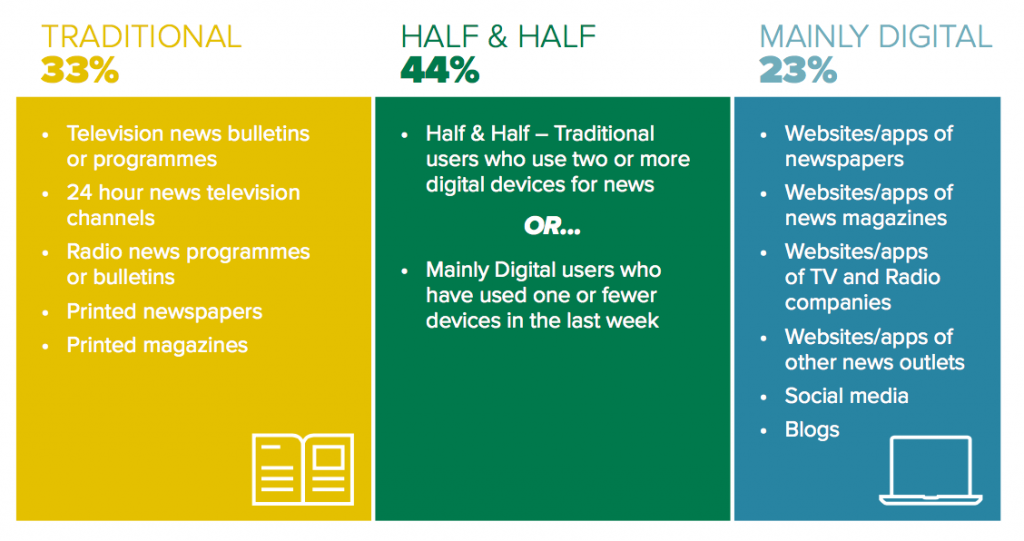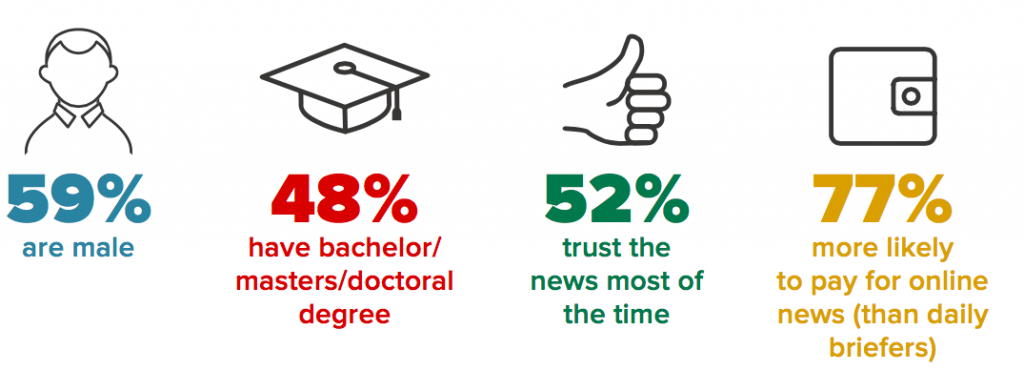As in previous years we have created a number of segmentations to help us interpret the results. These give us a non-overlapping categorisation of the online news universe that we can apply across all of our countries.
Traditionalists vs Mainly Digital
Our first segmentation categorises respondents into those that exhibit traditional approaches (mainly TV, radio and print) and those that are mainly digital in the way they consume the news. We also identify a sizeable group that are half and half (platform agnostic). The following table explains how these segments have been achieved.
SEGMENTATION BY SOURCES AND DEVICES
Looking at the results of these segmentations by country we find that France (44%) and Germany (50%) still have the largest percentage of our online sample accessing news in mainly traditional ways. In Germany, for example, there is a strong tradition of sitting down and watching the evening TV bulletins like Tagesschau while online news is less heavily used than elsewhere. By contrast, Korea, Norway, Sweden, and Greece have a more strongly digital profile.
We need to be careful in interpreting these results. The Brazil and Turkey samples are predominantly based in cities and will tend to be younger and not be fully representative of the national picture. Italy and Spain also have lower internet penetration so this data will significantly under-represent traditional media use. But it is still striking how different the patterns are – even in countries with very similar levels of internet penetration. A number of large countries are taking longer to adopt digital news use and we also find that within those countries there are particular groups that prefer traditional platforms, even when they use digital technologies for many other purposes (banking, e-commerce, etc.)
TRADITIONAL USERS VS MAINLY DIGITAL USERS – ALL COUNTRIES
| Traditional | Mainly Digital | |
|---|---|---|
| GER | 50% | 13% |
| FRA | 44% | 14% |
| AUT | 42% | 19% |
| BEL | 42% | 17% |
| CAN | 41% | 19% |
| JPN | 40% | 16% |
| ITA | 38% | 16% |
| NLD | 38% | 20% |
| UK | 38% | 23% |
| USA | 36% | 24% |
| HUN | 35% | 19% |
| POR | 34% | 18% |
| AUS | 33% | 25% |
| SUI | 33% | 23% |
| CZE | 33% | 26% |
| SPA | 31% | 22% |
| POL | 30% | 17% |
| IRE | 29% | 27% |
| TUR | 29% | 19% |
| FIN | 28% | 32% |
| DEN | 27% | 28% |
| BRA | 27% | 26% |
| KOR | 23% | 28% |
| NOR | 23% | 33% |
| SWE | 21% | 34% |
| GRE | 16% | 35% |
Base: Total sample in each country
WHO ARE THE TRADITIONALISTS?
Tend to be older, with lower level of education but they tend to trust the news more than mainly digital users.
News Lovers, Daily Briefers, and Casual Users
Our second segmentation is based on a mix of frequency and interest in the news. For example, news lovers are those that say they are extremely interested in the news and access it more than five times per day.
Some of these groups play more important roles than others in driving the new interactive news ecosystem. News lovers consume more, are more trusting of news organisations and journalists, share more, are better educated, and are almost twice as likely to pay for online news.




